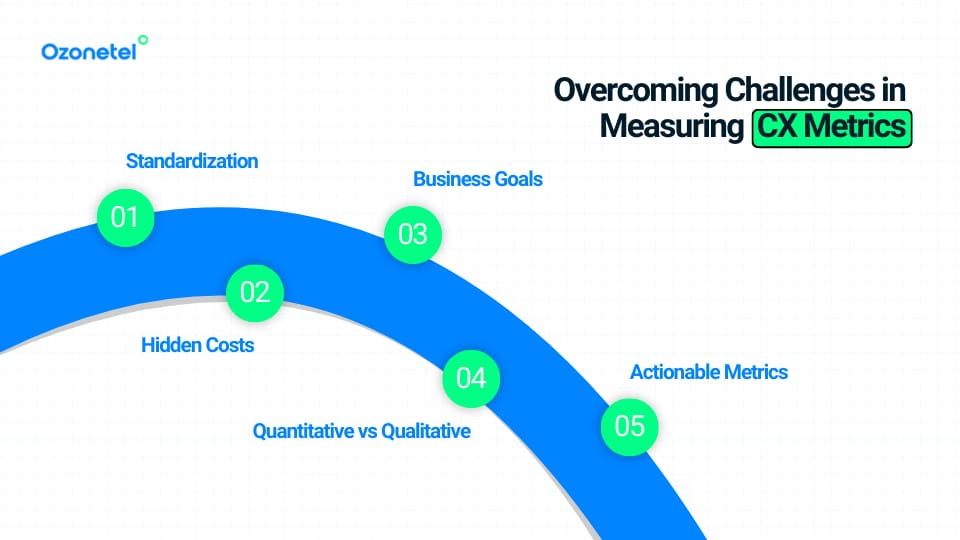- Resources
- The Ultimate Guide to Customer Experience Metrics (+ 6 Key CX Metrics That Truly Matter)
The Ultimate Guide to Customer Experience Metrics (+ 6 Key CX Metrics That Truly Matter)

Do you know how customers perceive your brand? Will your existing customers recommend your brand to other companies? Do customers find your brand to be the most efficient and less time-consuming while having any support interactions? Have you been able to track which customers were lost and which customers were retained?
If you need answers to these questions, then customer experience metrics is the way to go. These metrics provide you with a deep understanding of creating the perfect interaction with your customers. This includes providing them with exceptional support, earning their loyalty, and making your brand the most seamless in customer interactions.
In fact, most major firms with more than $1 billion in revenue have more than 50 CX metrics, with some having as many as 200, all owned and maintained by different people in various parts of the organization.
Read along as we discuss more about these metrics, how they benefit you and some real-life examples of brands leveraging these metrics!
In this article, we will explore:
- 1. What are Customer Experience Metrics?
- 2. Why are Customer Experience Metrics Important?
- 3. Essential Customer Experience Metrics to Understand Your Customers
- 4. Case Studies of Successful Customer Experience Metric Utilization
- 5. Challenges in Measuring CX Metrics and Tips to Overcome It
- 6. Upcoming Trends in CX Metrics
What are Customer Experience Metrics?
Customer experience metrics are instruments for assessing customer satisfaction and the effectiveness of their interactions with your products and services. These are qualitative and quantitative tools that help you gain a deeper understanding of your customers’ requirements and, consequently, help you analyze and improve the quality of your brand.
These metrics can help you enhance your processes to better serve your customers. How does this help? Properly resolving customer issues increases the likelihood of a client staying with your company by 2.4 times. Moreover, lowering the customer effort score (CES) by offering simple, easy-to-use products and services increases the likelihood that 76% of customers will suggest your brand to others.
Why are Customer Experience Metrics Important?
Customer experience metrics help you deep dive into your customers experiences while interacting with your products and services. It helps your brand to analyze areas of improvement and ideas that can be incorporated to make your products or services more in trend, innovative and visionary thereby increasing your revenues.
Satisfied customers are an excellent source of referrals, increasing your brand’s goodwill by recommending the ideal set of services you provide to other organizations. By providing insights for improved customer service, these tools aid in customer retention and reduce the expenses associated with acquiring new clients.
Any business that desires stability and long-term expansion must cultivate a loyal customer base. Customer experience metrics aid these loyal customers to remain affiliated with you for an extended period of time; consequently, they serve as a consistent revenue generator.
These tools easily gather the assessment of consumers quitting your services and the reasons why, enabling you to make the necessary improvements and address the primary issues or areas that have turned these consumers away.
These metrics also conveniently track the promptness with which you have attended to your customers and the time taken to resolve their issues. Such analysis helps you, as a brand, incorporate evolved measures to reduce any discrepancies or delayed responses to improve your customer service support system.
Also, your involvement with customers gives you a competitive advantage over your competitors. The most functional and prompt customer support generates the most loyalty, and customers turn to brands that are more involved. Customer metrics tools help you partner with your customers in their different stages of interacting with your brand. Being involved in their journey and transforming their experiences will always ensure loyalty to your brand.
Essential Customer Experience Metrics to Understand Your Customers

Once you have essential customer experience metrics in place, you need to analyze their effectiveness. You can measure your customer support system using the following key parameters:
- Customer Satisfaction (CSAT): You can see how your customers have reviewed your services by rating them from 0 to 10 based on their experience with your brand. Using CSAT software can help you clearly understand how satisfied your customers are with your brand and how impactful your services are for them.
- Customer Sentiment Analysis: What is the emotion that your customers experience when interacting with your brand? What is their comfort level? It is important to analyze customer conversations both on voice and non-voice channels. Sentiment analysis tools like Speech Analytics solution can help businesses categorize the tone (positive, negative, neutral) of these conversations and be used to train agents and provide better experiences.
- Net Promoter Score: Net Promoter Score (NPS) helps identify loyal customers who could potentially refer others, promoting your brand’s goodwill and ensuring smooth customer support operations. Scores range from -100 (extreme detractors) to 100 (promoters). To enhance your Net Promoter Score (NPS), focus on addressing feedback from detractors and improving their experience.
- Customer Effort Score (CES): You can measure how effective your support staff was in resolving issues faced by your customers. What was the turnaround time for understanding and solving their problems? These metrics allow customers to rate their level of interaction satisfaction.
- Customer Lifetime Value (CLV): By analyzing CLV, you can calculate the total revenue a business can generate from one customer’s association with your brand. It helps identify valuable customers and tailor experiences to retain them.
- Customer Churn Rate: Churn rate analysis provides your business with insights into consumers who chose to withdraw their services and move to your competitors. To tackle this, businesses must identify reasons for churn through surveys or exit interviews and proactively address these issues
Case Studies of Successful Customer Experience Metric Utilization
Now that you’ve a good idea of what customer experience metrics are, understand their importance, and the various ways to measure them, it’s time to see the tangible benefits they offer! The following case studies demonstrate some of the many ways that brands have leveraged CX to optimize their operations. Keep reading as we explore how companies efficiently use metrics to drive positive change and improve customer interactions.
Apollo Munich
The company identified, via its CSAT tool, that its clients were uneasy with the time-consuming nature of insurance update provision; consequently, the organization developed a customer portal that enabled clients to receive real-time policy updates and upgrade their coverage immediately. This fostered consumer confidence, and they subsequently emerged as the most dependable advertisers in terms of acquiring new clients.
Wakefit
For the innovative e-commerce brand Wakefit, delivering an exceptional customer experience was paramount. However, they faced challenges with response times, delivery failures, and product returns. By integrating Ozonetel’s CX platform, they orchestrated a transformative shift.
Implementing smart IVRs and self-service options reduced repeat queries by a staggering 26%, leading to a remarkable 400% surge in first-contact resolution rates. Additionally, their automated delivery confirmation process minimized failed deliveries by 10%, optimizing logistics costs.
But that’s not all – through proactive awareness campaigns, Wakefit empowered customers with product knowledge, resulting in a 5% reduction in product returns. The collaboration between technology and customer-centricity paid off, with Wakefit witnessing a 25% decrease in operational costs and a 25% reduction in resolution times.
PM JAY
The National Health Authority (NHA) embarked on an ambitious journey to enhance the healthcare experience for over 550 million Indians through PM-JAY. By partnering with Ozonetel, they harnessed the power of AI-driven speech analytics to meticulously analyze a staggering 122,000+ hours of conversations across 11 vernacular languages.
This data-driven approach enabled NHA to pinpoint areas for improvement, tailor training programs for their 900+ healthcare advisors, and ultimately boost first-contact resolution rates. Moreover, sentiment analysis empowered them to predict future queries, fostering a proactive approach to citizen support.
The result? A significant leap in citizen satisfaction and a streamlined remote supervision process, saving supervisors a remarkable 30 hours per month.
Disney
Disney has consistently provided us with a magical and surreal experience. However, when it encountered customers who were having significant difficulties navigating through its parks, it took action. Disney paid close attention to the feedback it received from its customers. Disney then innovated their customer experience by providing wristbands to its visiting consumers, enabling them to access all features, including hotel stays, simply by scanning their wristbands.
Challenges in Measuring CX Metrics and Tips to Overcome It

While the advantages of CX metrics are undeniable, measuring them effectively can be a hurdle. Let’s dive into some of the common challenges companies face when quantifying the customer experience, along with practical tips to overcome them.
Standardization
You know how it goes – every customer has their own unique perspective and way of expressing their experience. While this diversity is great, it can make standardizing customer feedback quite the struggle, right? Adopting a one-size-fits-all approach might end up leaving some customers feeling unheard or misunderstood. Now, we don’t want that!
So, how do we overcome this? By leveraging a well-crafted blend of metrics like CSAT, NPS, and CES. Combining these tools helps you capture a more holistic picture of the customer experience, without compromising on the personal touch. It’s like having a multilingual translator who ensures no feedback gets lost in translation!
Hidden Costs
Implementing top-notch CX metrics isn’t exactly a walk in the park, especially for smaller businesses. Investing in the latest technologies can put a serious dent in those annual budgets. But don’t worry, there’s a way to have your metrics and profit too.
The key lies in selecting metric software that aligns perfectly with your organizational goals. Start small and over time, you can upgrade the metric tools to align with your growth trajectory. With increased profits, businesses can afford to invest in the best software, crafted as per their organizational goals.
Business Goals
There are a variety of CX software programs on the market, meaning that selecting the one that resonates with your brand can get overwhelming. So, you need to start by asking yourself a simple question: “How will an effective feedback system benefit our organization and its goals?”
Your go-to metrics software includes customer feedback mechanisms that resonate with your business goals. Your business objectives can also change with time if you choose to expand or introduce new products and services. Aligning customer metrics with organizational goals can greatly reduce the challenges of selecting the appropriate customer experience metrics.
Quantitative vs Qualitative
Customer feedback is often a mixed bag of emotions – joy, frustration, delight, you name it. Trying to quantify these qualitative outbursts can feel like trying to solve a Rubik’s cube blindfolded.
To tackle this, data integration tools can transform those emotional responses into tangible, quantifiable data. Think of them as a team of translators who can decipher customer sentiment with ease, allowing you to roll out targeted engagement solutions and drive innovation (and profits, of course!).
Actionable Metrics
We’ve all been there – drowning in a sea of data from various platforms, struggling to keep our heads above water. It’s overwhelming, and it can delay the actual improvements your customers are craving. Here is where internal training plays an integral role. With trained staff, organizations can have the latest feedback and grievances accumulated at a fast pace and, hence, promptly incorporate improvements and innovative products and services.
Upcoming Trends in CX Metrics
While CX metrics shall continue to evolve, the upcoming trends shall include the below mentioned points:
Generative AI
This cutting-edge technology has the potential to analyze vast amounts of customer data, identify patterns, and generate tailored responses that resonate with each individual’s unique preferences and behaviors. By leveraging generative AI, businesses can provide highly contextualized and meaningful interactions, elevating customer satisfaction to new heights.
Moreover, generative AI can streamline customer support operations by efficiently handling routine inquiries, freeing up human agents to focus on more complex issues. This synergy between artificial and human intelligence promises to enhance overall efficiency, reduce response times, and deliver a seamless omnichannel experience.
Omnichannel Concept
The omnichannel approach to CX metrics emphasizes seamless integration, ensuring that customers can effortlessly transition between channels without losing context or repeating themselves. This holistic approach not only streamlines the customer journey but also fosters trust and loyalty by demonstrating a deep understanding of individual preferences and needs.
Omnichannel CX metrics will track customer interactions across multiple channels, providing a comprehensive view of the customer experience. By analyzing this data, businesses can identify pain points, optimize processes, and tailor their strategies to deliver a truly unified and personalized experience.
Sustainable CX
As consumers become increasingly conscious of their environmental impact, sustainability has emerged as a crucial factor in shaping customer experience. In 2024 and beyond, companies will prioritize incorporating sustainability metrics into their CX strategies, demonstrating their commitment to ethical and responsible business practices.
By providing transparency into their environmental footprint and mitigation efforts, businesses can foster trust and resonate with customers who value sustainability. This commitment not only aligns with consumer values but also positions companies as responsible corporate citizens, enhancing their reputation and cultivating long-term loyalty.
Chatbots
Chatbots, powered by advanced natural language processing and machine learning algorithms, are rapidly evolving into intelligent assistants capable of delivering personalized and contextual support. As chatbot technology matures, businesses will incorporate chatbot-related metrics into their CX strategies, measuring factors such as response accuracy, conversational fluency, and customer satisfaction.
Intelligent chatbots have the potential to handle a wide range of customer inquiries, provide 24/7 support, and seamlessly escalate complex issues to human agents when necessary. By integrating chatbots into their CX ecosystem, companies can reduce response times, enhance customer convenience, and free up human resources to focus on more intricate tasks.
In conclusion
The field of CX metrics is evolving – it is the most sacrosanct aspect of operating a growing market. It not only provides you with a competitive advantage, but it also contributes to organizational growth. Also, these metrics play a crucial role in driving innovation and bringing about revolutionary changes in any country’s economy.
Organizations can play a pivotal role in a country’s overall economic growth, and CX metrics are the most revolting tools for doing so. Customer feedback will always be a source of information and innovation; hence, these metrics play the most crucial role in organizational as well as economic developments.
Ready to take control of your call transfer
experience for better CX outcomes?
Prashanth Kancherla
Chief Product Officer, Ozonetel Communications
Over the past decade, Prashanth has worked with 3000+ customer experience and contact center leaders...
Chief Product Officer, Ozonetel Communications
Over the past decade, Prashanth has worked with 3000+ customer experience and contact center leaders to comprehensively understand the need for effective and efficient customer communications at every step of their journey with a brand. Deeply embedded in today’s CCaaS ecosystem, he has been instrumental in Ozonetel's growth and contributed in various roles including product management, sales, and solution architecture.







